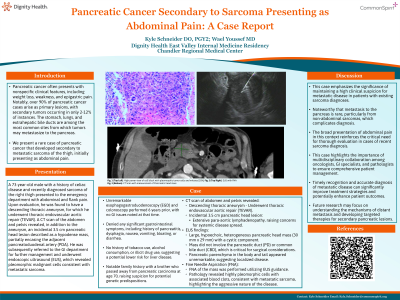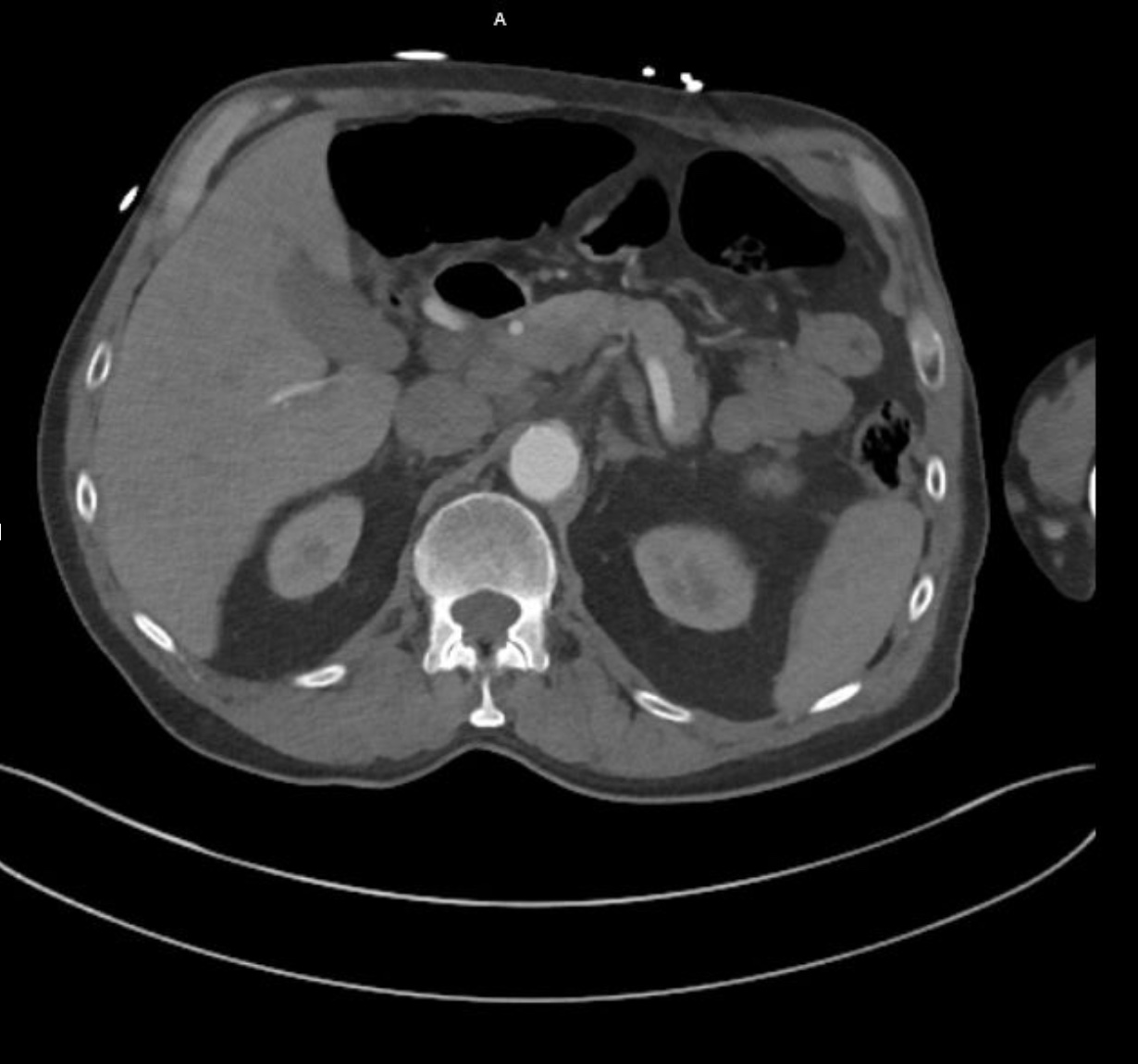Monday Poster Session
Category: Biliary/Pancreas
P1834 - Pleomorphic Sarcoma of Thigh with Metastasis to the Pancreas Presenting as Abdominal Pain
Monday, October 28, 2024
10:30 AM - 4:00 PM ET
Location: Exhibit Hall E

Has Audio

Kyle Schneider, DO
Dignity Health East Valley
Chandler, AZ
Presenting Author(s)
Kyle Schneider, DO1, Wael youssef, MD2
1Dignity Health East Valley, Chandler, AZ; 2Creighton University, Phoenix, AZ
Introduction: Pancreatic Carcinoma can manifest with broad presentation, including vague symptoms which may present similar to an array of oncologic etiologies making it a daunting diagnostic challenge. Exacerbating this challenge is the fact most pancreatic cancers are primarily rather than secondary. Confounding proper diagnostics even further is the fact sarcomas yield relatively low association for pancreatic metastasis.
Case Description/Methods: A 73 year old male with a reported PMH: celiac disease, depression, PTSD and recently diagnosed sarcoma involving right thigh presented to the emergency department with a chief complaint of abdominal and flank pain with ultimate finding of descending thoracic aneurysm for which he underwent TEVAR. On emergent evaluation imaging studies revealed, along with aforementioned aneurysm, an incidental finding of 3.5cm pancreatic head lesion radiologically described as hypodense mass partially encasing the adjacent PDA. The GI department was consulted and on initial evaluation it was revealed the patient had no history of tobacco use however his brother passed from pancreatic cancer. EUS/FNA was completed indicating a large hypoechoic round heterogeneous head of pancreas mass with a cystic component measuring 30mmx29mm. FNA: Pleomorphic malignant cells consistent with metastatic sarcoma. Throughout the patient's hospital course they were seen by oncology and started on chemotherapy.
Discussion: The overwhelming majority of pancreatic carcinomas are primary with 94% being primary tumors. In academic literature pancreatic cancer as a secondary tumor originates from the abdominal or thoracic cavity with high incidence. The stomach, lungs, and extrahepatic bile ducts are among the most common primary tumor sites with spread to the pancreas. This case illustrates the importance of carcinoma surveillance and maintaining appropriate clinical suspicion after diagnosis of sarcoma. Metastasis to the pancreas is rare with sarcoma especially non-abdominal such as this case. A broad presentation of abdominal pain further illustrates the importance of clinical acumen when approaching patients with recent sarcoma diagnosis. In this case, the patient presented to the ED with vague abdominal pain and CT scan completed in the emergency department indicated an approximate 3.5 x 2.9 x 3.3 cm mass involving the pancreatic head. This allowed EUS to be completed with the eventual discovery of pleomorphic malignant cells consistent with metastatic sarcoma.

Disclosures:
Kyle Schneider, DO1, Wael youssef, MD2. P1834 - Pleomorphic Sarcoma of Thigh with Metastasis to the Pancreas Presenting as Abdominal Pain, ACG 2024 Annual Scientific Meeting Abstracts. Philadelphia, PA: American College of Gastroenterology.
1Dignity Health East Valley, Chandler, AZ; 2Creighton University, Phoenix, AZ
Introduction: Pancreatic Carcinoma can manifest with broad presentation, including vague symptoms which may present similar to an array of oncologic etiologies making it a daunting diagnostic challenge. Exacerbating this challenge is the fact most pancreatic cancers are primarily rather than secondary. Confounding proper diagnostics even further is the fact sarcomas yield relatively low association for pancreatic metastasis.
Case Description/Methods: A 73 year old male with a reported PMH: celiac disease, depression, PTSD and recently diagnosed sarcoma involving right thigh presented to the emergency department with a chief complaint of abdominal and flank pain with ultimate finding of descending thoracic aneurysm for which he underwent TEVAR. On emergent evaluation imaging studies revealed, along with aforementioned aneurysm, an incidental finding of 3.5cm pancreatic head lesion radiologically described as hypodense mass partially encasing the adjacent PDA. The GI department was consulted and on initial evaluation it was revealed the patient had no history of tobacco use however his brother passed from pancreatic cancer. EUS/FNA was completed indicating a large hypoechoic round heterogeneous head of pancreas mass with a cystic component measuring 30mmx29mm. FNA: Pleomorphic malignant cells consistent with metastatic sarcoma. Throughout the patient's hospital course they were seen by oncology and started on chemotherapy.
Discussion: The overwhelming majority of pancreatic carcinomas are primary with 94% being primary tumors. In academic literature pancreatic cancer as a secondary tumor originates from the abdominal or thoracic cavity with high incidence. The stomach, lungs, and extrahepatic bile ducts are among the most common primary tumor sites with spread to the pancreas. This case illustrates the importance of carcinoma surveillance and maintaining appropriate clinical suspicion after diagnosis of sarcoma. Metastasis to the pancreas is rare with sarcoma especially non-abdominal such as this case. A broad presentation of abdominal pain further illustrates the importance of clinical acumen when approaching patients with recent sarcoma diagnosis. In this case, the patient presented to the ED with vague abdominal pain and CT scan completed in the emergency department indicated an approximate 3.5 x 2.9 x 3.3 cm mass involving the pancreatic head. This allowed EUS to be completed with the eventual discovery of pleomorphic malignant cells consistent with metastatic sarcoma.

Figure: CT Abdomen & Pelvis: Pancreatic Mass
Disclosures:
Kyle Schneider indicated no relevant financial relationships.
Wael youssef indicated no relevant financial relationships.
Kyle Schneider, DO1, Wael youssef, MD2. P1834 - Pleomorphic Sarcoma of Thigh with Metastasis to the Pancreas Presenting as Abdominal Pain, ACG 2024 Annual Scientific Meeting Abstracts. Philadelphia, PA: American College of Gastroenterology.
